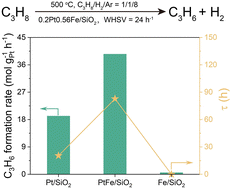A promoted PtFe/SiO2 catalyst with low Pt concentration for propane dehydrogenation†
Abstract
Non-oxidative propane dehydrogenation (PDH) has developed into one major way to increase propylene production because of its unique advantages. The harsh reaction conditions put forward higher requirements for the activity and stability of catalysts. Herein, we successfully prepared PtFe/SiO2 that presents excellent catalytic performances for PDH. The introduction of an Fe component is conducive to the high dispersion of Pt and restrains the migration of Pt that leads to agglomeration. Electrons are transferred from Fe to Pt species, forming an electron-rich Pt state that facilitates propane adsorption and propylene desorption. Meanwhile, electron-rich Pt sites are created in PtFe/SiO2, leading to the improvement of both propylene formation rate and mean lifetime compared to Pt/SiO2. PtFe/SiO2 exhibits good catalytic activity and high stability with nearly 100% propylene selectivity. The initial C3H6 formation rate reached 39.52 molpropylene gPt−1 h−1 and the mean lifetime was 83 h under these conditions: 500 °C, C3H8/H2/Ar = 1/1/8 and a weight hourly space velocity (WHSV) for propane of 24 h−1. As the WHSV increased to 48 h−1, the initial C3H6 formation rate could reach 72.75 molpropylene gPt−1 h−1. This work paves the way for developing robust Pt-based PDH catalysts via alloying with earth-abundant metals.



 Please wait while we load your content...
Please wait while we load your content...